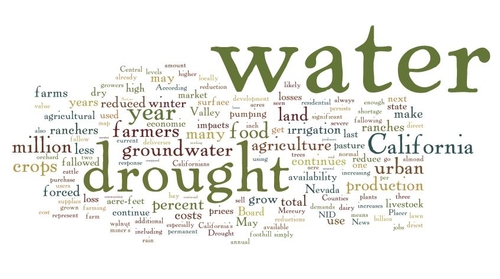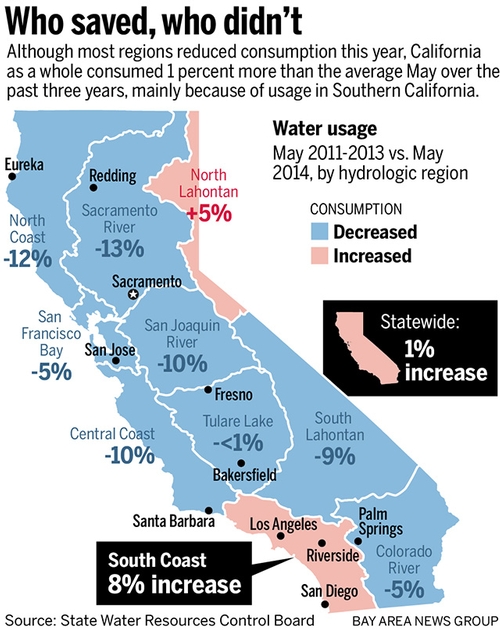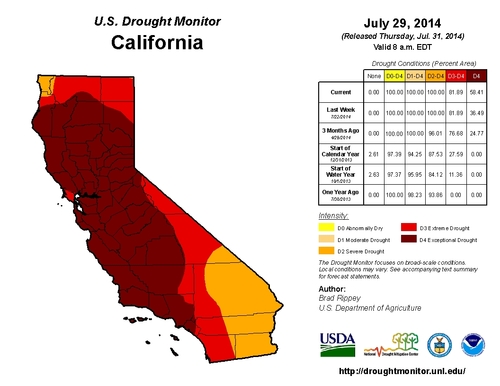

On the same day that the Mercury News printed this graphic, the UC Davis Center for Watershed Sciences released its “Economic Analysis of the 2014 Drought for California Agriculture.” Lest there be any doubt that California is in the midst of a severe drought that is having profound impacts on farmers and ranchers, here are a few of the study's key findings:
- California is enduring its third driest year on record as agricultural, urban and environmental demands for water are at an all-time high. In other words, this year has been one of the driest in our history – and California's population has never been higher.
- The 2014 drought is responsible for the greatest absolute reduction to water availability for agriculture ever seen, given the high agricultural demands and low streamflows and reservoir levels. Surface water availability is expected to be reduced by about one-third.
- The 2014 drought will result in a 6.6 million acre-feet reduction in surface water available to agriculture. This loss of surface water will be partially replaced by increasing groundwater pumping by 5 million acre-feet.
- The net water shortage of 1.6 million acre-feet will cause losses of $810 million in crop revenue and $203 million in dairy and other livestock value, plus additional ground water pumping costs of $454 million. These direct costs to agriculture total $1.5 billion.
- The total statewide economic cost of the 2014 drought is $2.2 billion, with a total loss of 17,100 seasonal and part-time jobs.
- California farmers will fallow approximately 428,000 acres of farmland in 2014 (other reports put this estimate as high as 800,000 acres). Most of the fallowed land is estimated to be feed and other annual crops, including pasture. At the individual farm level, fallowing land creates significant cash-flow challenges. Some farms may not survive economically; some may be forced to sell land for development. These farms and ranches grow food for all of us! Each fallowed acre reduces the amount of food and fiber available for all Californians!
- In the Central Valley, high-value crops including vegetables, non-tree fruits and permanent crops represent less than 13 percent of total fallowing as growers direct scarce water to the highest value use. Scarce water supplies are being used to keep almond, pistachio and walnut trees alive, rather than to grow annual field crops. These orchard crops represent significant capital expenditures; farmers can't simply fallow an orchard one year and resume production the next.
- Alfalfa hay prices have increased 40 percent since January 2014. This impacts the cost of production for dairy farmers, and to a lesser extent, for other livestock producers. Many foothill ranchers have already felt the impacts of this price increase; they had to purchase hay to make it through the exceptionally dry winter. Ranchers who market directly to consumers have had to raise their meat prices.
- The California drought, especially the lack of rain in the winter of 2013-2014 reduced pasture quality and the number of cattle [and other rangeland livestock] per acre substantially during the crucial winter and spring period of calving and raising feeder cattle on pasture. Once the grass started to grow in March and April, many ranchers did not have enough animals to fully utilize the forage, creating fuel-loading problems on many ranches. Several wildfires this summer have impacted ranches that were forced to de-stock during the winter.
- The combined socioeconomic (reduced production, job losses, economic losses, etc.) effects of the 2014 drought are up to 50 percent more severe than in 2009.
But what happens if the drought continues? According to the report, “Statistically, the drought is likely to continue through 2015 – regardless of El Nino conditions.”
- Failure to replenish groundwater in wet years will continue to reduce groundwater availability to sustain agriculture – particularly more profitable permanent crops – during California's frequent droughts. The recent plantings of almond and walnut orchards on the edges of the Valley are at risk.
- If the drought continues for two additional years, groundwater substitution will remain the primary response to surface water shortage, with decreases in groundwater pumping capabilities and increasing costs due to declining water levels.
- A continued drought also increases the vulnerability of agriculture, as urban users with largely adequate supplies in 2014 would likely buy water from agricultural areas. This means more land will be fallowed and more farms will go out of business.
Obviously, rural communities are especially vulnerable to the drought. Communities that depend on farming and ranching as their economic base are already suffering from the loss of jobs and farming income. Drought-induced reductions in food production (and related increases in production costs) will ultimately lead to higher food prices – at the supermarket as well as at the farmers' market. As the housing market recovers, many farm and ranch families may decide to sell their land for development.
So what can we do? We can't make it rain – believe me, I've tried everything I can think of! As farmers and ranchers, we must continue to hope for the best but prepare for the worst. We need to develop drought plans – what will we do if the drought continues? For my family's sheep operation, this means keeping a careful eye on our carrying capacity and stocking rates. For foothill fruit growers, this may mean deciding which trees to save and which to let die.
While most residential water users are used to having their water metered, much of the irrigation water in the foothills is delivered through a network of canals by the miner's inch (a vestige of our Gold Rush heritage, a miner's inch is equal to 11.22 gallons per minute). As an irrigator, I have two options for conserving water: I can purchase less water from my irrigation district, or I can invest in technology and management systems that allow me to irrigate more acreage with my full allotment of water. On several of our leased pastures, we've opted to make our water go further. If the Nevada Irrigation District (NID) is forced to reduce deliveries next year by a fourth consecutive dry year, we'll have to get by with less – and reduce our flock accordingly. We simply don't have the ability to replace our NID water with groundwater.
What can we do at home? We've always turned off the tap while brushing our teeth and shaving. This year, we're putting a bucket in the shower while waiting for the water to get hot – and we're using this water for plants and for drinking water for our pets. We've also limited the amount of landscaping irrigation that we're doing – our lawn is drier than normal, and we're using some of our yard space to grow food instead of ornamental plants. If the drought continues, we'll consider tearing out more lawn.
Drought has always been a fact of life for California. I've seen evidence that the last half of the 20th Century were wetter than normal for our state – perhaps drought is more ordinary than we realize. And while many farms and ranches have learned to get by on less water, the map at the beginning of this article suggests that many of our urban neighbors are not aware that we're in a drought. If our current dry spell persists, however, we'll all be forced to make some difficult decisions.
Here's the bottom line: no matter how we define “locally grown,” if the drought persists, we'll all have difficulty finding locally grown food!
